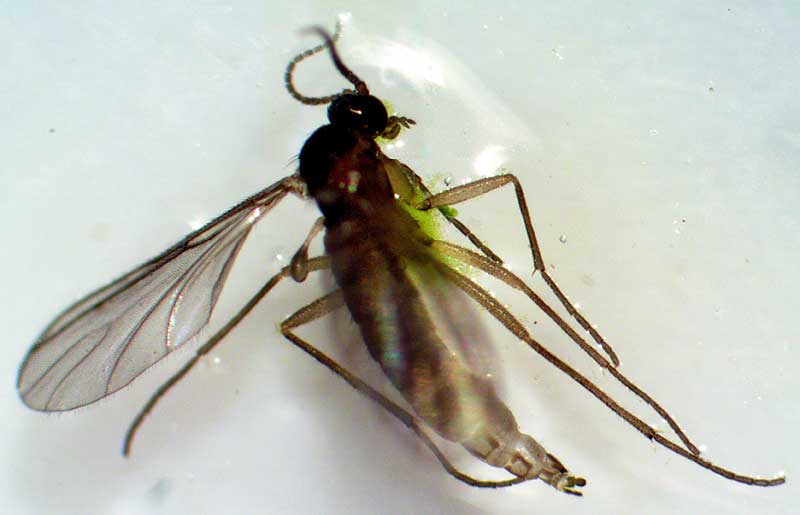Excerpts from Jim Conrad's
Naturalist Newsletter

from the January 26, 2014 Newsletter issued from the Frio Canyon Nature Education Center in the valley of the Dry Frio River in northern Uvalde County, southwestern Texas, on the southern border of the Edwards Plateau; elevation ~1750m (~5750 ft); N29.62°, W99.86°; USA
DARK-WINGED FUNGUS GNAT
Several goldfish bowls stand on one of Juniper House's windowsills filled with water, mud, pebbles, decaying leaves and interesting blobs of algae and cyanobacteria from the little Dry Frio. When morning's sunlight slants through the window, the bowls' waters are thick with bright specks of microscopic critters swimming about. New things turn up constantly, snails hatching, planaria wandering across leaves, tiny aquatic insect larvae pulling themselves onto emerging vegetation, molting and flying away. Every day each bowl has new stories to tell.
The other day a tiny winged insect only about 1mm long (1/32 inch) -- what most people would call a gnat -- turned up in one of the bowls floating dead on its side at the water's surface. I didn't know what the gnat was doing there, but it seemed that here was a good chance to learn more about gnats. The little being was fished from the water, placed beneath the dissection scope, and you can see the resulting image above.
What encouraged the hope that this gnat might be identifiable was the way it lay on its side so clearly displaying the veins in a wing. In the world of insect identification, wing venation is like fingerprints for human identification. Surfaces between veins form "cells," and cell configuration is constant from species to species.
Mostly on the basis of wing venation, volunteer identifier Bea in Ontario figured out that we had a member of the insect family known as the Sciaridae, members of which often are called dark-winged fungus gnats, which commonly are found in moist environments. About 1700 species of dark-winged fungus gnats are known, but it's estimated that about 20,000 are awaiting discovery, mainly in the tropics. Among features making good field marks for recognizing dark-winged fungus gnats are the long legs, the long, slender abdomen, and the threadlike antennae consisting of several segments.
In the picture you might notice that behind the extended wing there's a small spoon-shaped object. That's a modified back wing known as a halter or haltere. Halteres function as gyroscopes, helping keep the insect's body from rotating during flight. Since halteres are modified back wings, they occur only on insects with one pair of wings. In fact, gnats belong to the Fly Order, the Diptera, containing species with only one pair of wings.
Though we don't hear much about "dark-winged fungus gnats," if we spend even a little time outdoors we're bound to have noticed them. Studies show that in many moist and shadowy areas, up to 70% of all two-winged species encountered can be members of this family, the Sciaridae. Though adult gnats flitting around eyes and ears can be a bother, we can be grateful to the larvae of many species for performing the important role of turning leaf litter into soil.
By no means are all gnats dark-winged fungus gnats. The word gnat is a general term applied to many different kinds of tiny fly-like or two-winged insects. About as technical as you can get in saying what a gnat is, is that it's a tiny flying insect in the Dipterid suborder Nematocera, especially in the families Mycetophilidae, Anisopodidae and Sciaridae. To confuse matters more, in British English even certain blood-sucking mosquitoes are called gnats.